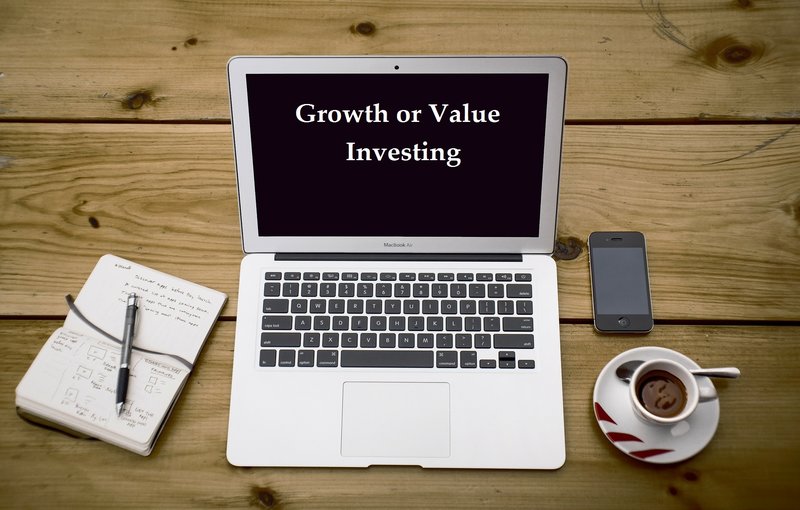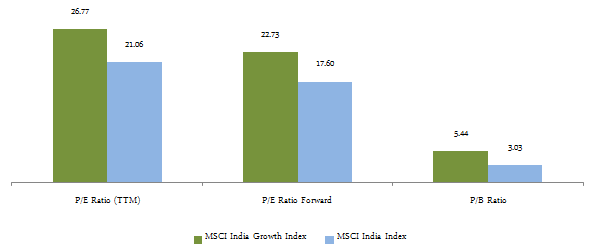Understand investment styles to make smarter decisions: Growth Investing

When looking at different mutual funds for investments, you may have come across scheme names like ABC Growth Fund or XYZ Value Funds (ABC and XYZ being the AMC names). The scheme name itself, sometimes, gives the investor important clues about the nature of the investment. I have italicized sometimes because, unfortunately in India, that is not always the case. Fund houses have so many schemes of similar type that they have to create scheme names which contain no useful information for the investor. Anyways, sometimes the scheme name itself will give you clues about the market cap segment and the investment style of a mutual fund scheme. For example, a Top 100 or Top 200 or Bluechip scheme will invest in large market cap companies. A Midcap or Smaller companies or Emerging Equity scheme will invest in mid or small market cap companies. Growth Funds or Value Funds refers to the investment style of the fund manager. In this two part series, we will discuss about different investment styles, especially in the context of mutual funds, so that you understand how the fund manager picks stocks for your fund.
There are two broad investment styles, Growth Investing and Value Investing. Some fund managers prefers Growth Investing style, while others prefer Value Investing style. There is a third investment style, Growth at Reasonable Price (GARP), which combines the tenets of both Growth and Value Investing. A teacher once told me that, unlearning misconceptions is the first step of learning a topic. Therefore, let us first dispel some common misconceptions regarding growth and value investing.
- Misconception: Growth investment style is for shorter investment tenures, while value investment is for longer tenures.
Reality: Both growth and value investment styles work best over longer investment tenures. Both growth and value funds have given great returns over investment periods of 10 years. - Misconception: Growth funds are more risky; value funds are less risky.
Reality: Both are risky. We have discussed a number of times in our blog that investors should understand risk in the context of their investment timeframe. It is the true that, at the start of deep correction or bear market growth stocks may correct more than value stocks, because growth stocks may be perceived to be more expensive than value stocks, from a valuation standpoint. But you should also know once the correction is over, growth stocks recover faster than value stocks. - Misconception: Growth stocks give higher returns than value stocks.
Reality: Historical returns of MSCI India Value Index (index of Value Stocks) and MSCI India Growth Index (index of Growth Stocks) shows that, in the last 10 years (period ending June 2016), MSCI Value Index gave higher returns than MSCI Growth Index. - Misconception: Value stocks give higher returns than growth stocks.
Reality: In the last 5 years (period ending June 2016), MSCI Growth Index gave higher returns than MSCI Value Index. Growth and Value stocks have outperformed each other over different market periods. Generalizations like one style giving higher returns than the other style, is incorrect and misleading. - Misconception: Value stocks are mid or small cap stocks
Reality: Fund managers can find value stocks in all market cap segments. If you look for value funds, you will see that, a large number of value funds are multicap or flexicap funds, with allocations in both large cap and midcap segments.
Now that, we have unlearnt the misconceptions, let us now discuss each investment style in more details.
Growth Investing
In the growth investing style, investors or fund managers focus on companies, where they expect higher than average revenue and earnings (EPS) growth. Since the EPS of growth stocks grow faster than benchmark (e.g. Sensex, Nifty, BSE – 100, BSE – 500 etc) EPS, the market reward growth stocks with higher prices. In other words growth stocks are likely to have higher Price to Earnings (P/E ratio) or Price to Book (P/B ratio). If you compare the valuation ratios of MSCI India Growth Index and MSCI India Index (which combines both MSCI Growth and Value Indices), you will see that the valuation ratios of MSCI India Growth Index is higher than that of MSCI India Index (please see the chart below).

Source: MSCI Factsheet
Some people like expensive things, while some people like cheap things. It is not possible for us to say, who is right or wrong; it depends on what the buyer wants. If a stock is expensive, it is not because the company wants their valuation to be high; it is because the market (which represents the collective wisdom of all the investors) thinks that the higher price is warranted. In other words, if a stock is expensive, there is a reason, why it is expensive. Share prices of a growth stock, grows faster during the initial phase of a rally. This is because the market looks for earnings growth, and in the initial phase of the bull market, growth stocks have the potential to give higher earnings growth and good growth stocks are successful in delivering on the potential.
Market rewards higher earnings and therefore, share prices of growth stocks tend to rise faster in the initial part of the bull market rally.
Investors should, however, realize that, share prices are a function of demand and supply. Investors want to make profits and in the early or mid part of a bull market, the higher capital appreciation of growth stocks increases demand for these kind of stocks. Higher demand leads to higher prices, and in a momentum driven market like ours (in India), this causes share prices to run ahead of their earnings potential. In other words, at the peak of the bull market, valuations of growth stocks can appear to be stretched. Bull market peaks are, inevitably, followed by corrections, which can lead to a bear market. At the peak of the bull market and at the beginning of a bear phase, investors rush to book profits in stocks, which are perceived to be expensive. Therefore, growth stocks tend to underperform when the markets are falling.
Over the last many years, I have observed that, in India the market continues to reward winners even if valuations appear stretched and punish losers, even after they have corrected substantially. What this means is that, many growth stocks can continue to give high returns for a long period, while undervalued stocks can remain cheap for a long period, till the liquidity situation in the market changes.
On the other hand, I have also seen that, corrections from market peaks can be very brutal. This means that, a growth stock today can become a value stock in the next correction. If you see the constituents of MSCI India Value Index, many constituents were growth stocks just a few years back (e.g. Axis Bank is a constituent of MSCI India Value Index, whereas it was a high beta growth stock just a few years back). Similarly a value stock today can become a growth stock tomorrow.
Characteristics of Growth Stocks
Let us now discuss a few characteristics of growth stocks, which investors should know when making their investments.
- High growth companies operate in markets that are either at the start of a long term growth cycle or in a growth cycle. Companies in markets that are in the tail end of a growth cycle are not suitable for high growth companies.
- High growth companies should have a large target market. Companies which sell to niche segments can have good operating margins, but will not be able to sustain high revenue and sales growth for a long period of time. Investors who prefer growth stocks, should look for companies with huge market potential,
- Growth stocks should have proven track record of strong revenue growth. Great growth companies also have commanding market share. Good high growth companies also have a good product development record to sustain strong revenue growth over a long period of time.
- Good high growth companies have strong management teams. These companies are likely to invest their profits in new product development, capacity expansion, mergers and acquisitions (M&A) etc, as opposed to returning money to shareholders through dividends or share buyback. Dividend yield of MSCI India Growth Index (at 1.04%) is lower than dividend yield of MSCI India Index (at 1.36%). There is nothing wrong, if the company management reinvests profits in growth opportunities, because it will result in capital appreciation for shareholders. But then, not all investments give high ROIs. Therefore, fund managers spend a lot of time evaluating business models and management quality of growth stocks.
What is your investment style?
If you look the diversified equity mutual fund schemes which gave the highest return in the last 10 years, (please see Top Performing Mutual Funds - Equity Funds Diversified in our MF Research Centre), you will see that there are both value and growth funds among the top performing mutual funds. Though, theoretically, a value investor can wait for 20 years to get good returns from a stock, as far as mutual fund industry in India is concerned, Investors are unlikely to be that patient and therefore, there is pressure on even value fund managers to deliver good returns over a certain period of time.
However, since growth stocks can experience faster increase in share prices compared to value stocks, if you have shorter investment horizon, then growth funds may be more suitable for your investment needs. Please bear in mind that, we used the phrase shorter investment horizon, purely from a relative viewpoint because equity investors should always have sufficiently long investment horizon (most investment advisors suggest an investment period of at least three years for equity funds).
Growth stocks and funds are usually more volatile than value stocks and funds. Therefore, growth investors should have appetite for volatility. Growth stocks are more likely to be in the news most of the times; value stocks, on other hand, can experience long periods of anonymity. If you like to be part of the trend then you will like growth stocks and funds. If you want to track your investments frequently and want them to beat the market on a consistent basis, then growth stocks and funds will suit your better.
Conclusion
In this post, we discussed about growth investing style. We also discussed personality traits of growth investors. Individuals can have different style. No style is good or bad. You should go for investments that suit your personality better. In the next part of this series, we will discuss about Value investing style and also the blended style (value and growth) of equity investing. Please stay tuned......
Mutual Fund Investments are subject to market risk, read all scheme related documents carefully.
RECOMMENDED READS
LATEST ARTICLES
- Why you need to have hybrid mutual funds in your portfolio: Different types of funds Part 2
- Why you need to have hybrid mutual funds in your portfolio: Misconceptions Part 1
- Which is the best time to invest in mutual funds
- Economic slowdown: Is it real and what should you do
- Importance of liquidity in investing: Mutual funds are ideal solutions
An Investor Education Initiative by ICICI Prudential Mutual Fund to help you make informed investment decisions.
Quick Links
Follow ICICI Pru MF
More About ICICI Pru MF
POST A QUERY




